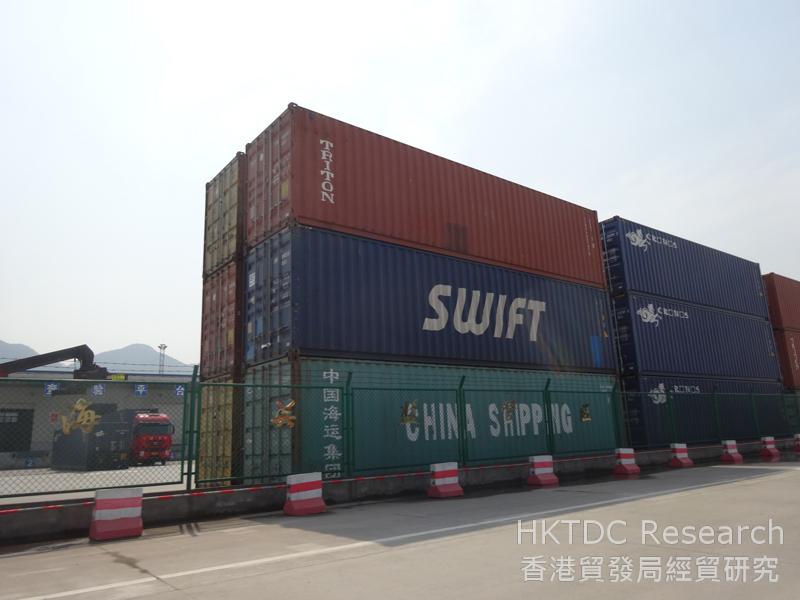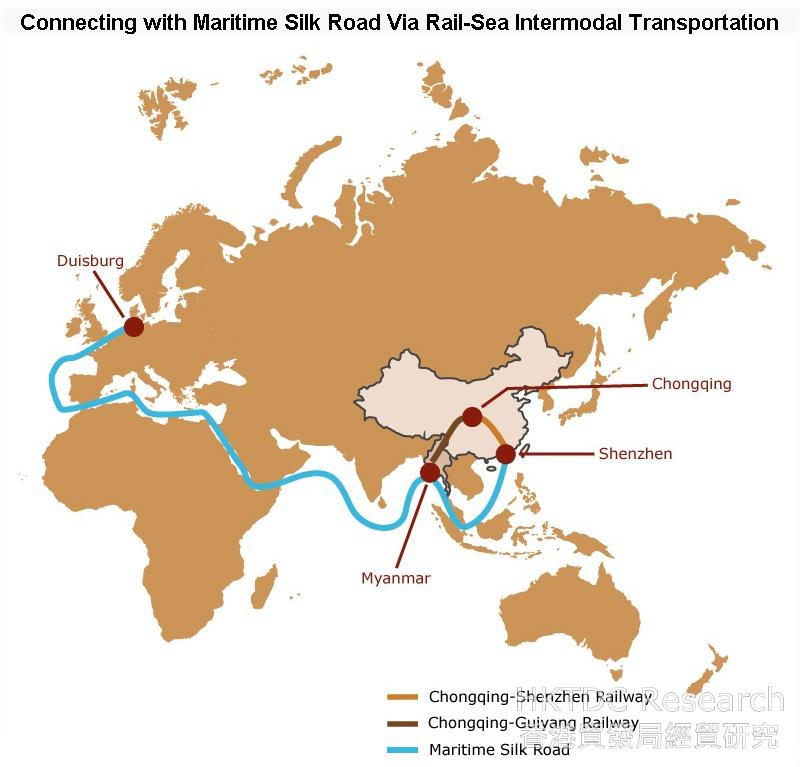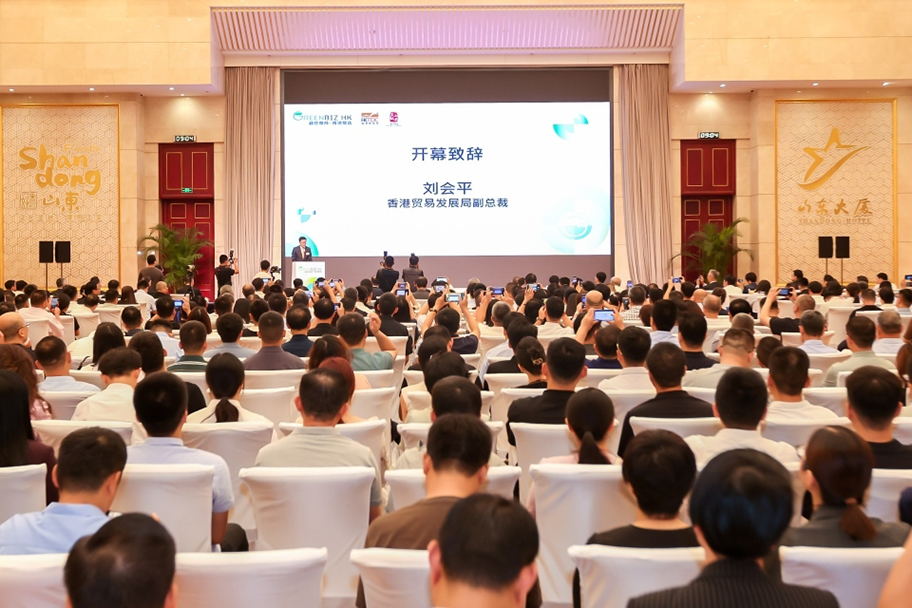One Belt One Road: Yuxinou Railway Development
HKTDC Research | 23 Jul 2015
One Belt One Road: Yuxinou Railway Development
As the transport hub of the Silk Road economic belt and Yangtze economic belt, Chongqing connects China’s eastern and western regions with the European markets. Its functions as a shipping centre in the upper reaches of the Yangtze River and a national logistics hub will be further strengthened in China’s new round of economic reform and opening up and implementation of the “One Belt, One Road” strategy. Rail-sea intermodal transportation connecting Chongqing and the “Maritime Silk Road” also opens international trade routes to South Asia and Southeast Asia. According to the Opinions on Implementing the Belt and Road Strategy and Building the Yangtze Economic Belt issued by the Chongqing municipal government in December 2014, investment by the municipal government in infrastructure projects will reach Rmb1.2 trillion by 2020. Among these, the Chongqing-Xinjiang-Europe international railway will be the main Eurasian land bridge between western China and the European markets. The railway is also known as the Yuxinou railway, an acronym for Chinese characters Yu (which stands for Chongqing), Xin (Xinjiang) and Ou (Europe).
Shortening Transport Time between Chongqing and Europe
The Yuxinou railway starts from Chongqing and runs northwestwards to Xi’an, Lanzhou and Urumqi on the Northern Xinjiang Railway to cross the Chinese border at Alataw Pass, where it enters Kazakhstan after changing gauge. It continues through Russia, Belarus and Poland (change gauge again) to arrive in Duisburg, Germany. Stretching 11,179 kilometres, it is hailed as the “New Silk Road”. Through the co-operation and support of China’s Ministry of Railways and General Administration of Customs and the governments of countries along the railway, this international rail link integrates existing railway networks and introduces “one-stop declaration, inspection and release” for faster customs clearance along the route.
The Yuxinou railway has greatly shortened transportation time between western China and Europe after its official opening on 18 March 2013. In the past, Europe-bound Chongqing exports were first shipped to Shanghai on the Yangtze River, where they were loaded onto larger ocean-going vessels to continue their shipment to Europe. The entire journey of this river-sea intermodal transportation usually took 45-60 days. Using the Yuxinou railway, it only takes 13 days to export goods from Chongqing to Germany. Besides saving time, this also improves the liquidity of working capital. The Yuxinou railway is still working on the improvement of speed. According to China Railway, transport time between Chongqing and Germany will be further shortened to 12 days after the railway becomes fully operational at the end of 2015.
Up to the end of 2014, a total of 233 trips had run on the railway, with freight volume amounting to 5.4 billion tonnes and the value of imports and exports transported totalling US$6.8 billion. Today, it has more than four trains leaving Chongqing for Europe and one train or more returning from Europe each week. It is estimated that about 300 trips will run on the railway in 2015 with onward and return trips each accounting for 50% of the journeys. The Yuxinou railway operates with fixed stations, fixed routes, fixed train numbers, fixed timetables and fixed prices. A more stable train service will enhance Chongqing’s ability to solicit cargo sources from the surrounding areas.
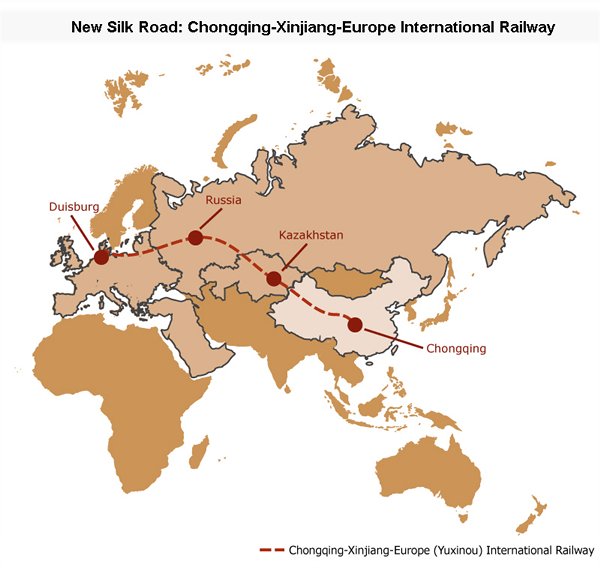
Cargo Sources: Greater Diversity and Larger Catchment Area
Chongqing’s industrial development has always had electronics and automotive industries as its two pillars. Electronic products and auto parts also form the bulk of goods exported to Europe via the Yuxinou railway. As Chongqing’s industries have become more diversified in recent years, the sources of goods have also increased. Today, cargo carried on the Yuxinou railway also includes machinery equipment, food, textiles and light products. The origins of goods also extend from Chongqing to places beyond, with Chongqing itself and the surrounding provinces accounting for 50%, eastern China for 30%, and southern China for 20%. Chongqing’s imports from Europe mainly include cars and auto parts from Germany and high-end consumer goods, timber, machinery equipment, chemicals and instruments from countries like Italy and Spain.
In addition to a larger catchment area for goods, the destinations of cargo shipments have also been extended to cities beyond the Yuxinou railway line to form a unique “1+N” pattern of convergence and distribution network. Here, “1” refers to the main line of the railway from Chongqing to Duisburg, while “N” refers to countries chosen by consignors as their points of convergence and distribution. Today, this has developed into a network of dozens of convergence and distribution points, including Rotterdam in the Netherlands, Antwerp in Belgium, Moscow and Cherkessk in Russia, Kutno in Poland, Pardubice in the Czech Republic, and Almaty and Kostanay in Kazakhstan. From another prospective, these convergence and distribution points may be taken as centres of European exports to Chongqing. Greater diversification of European goods exported from Europe to Chongqing will in turn further enrich the varieties of imported goods in the mainland market.
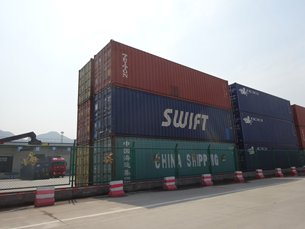
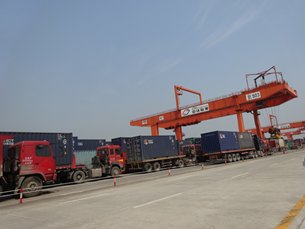
Railway Transport Cost Drops Steadily
According to a logistics company in Chongqing, goods are mostly exported from Chongqing to Europe by means of river-sea intermodal transportation because both the buying and selling sides are accustomed to this practice. However, as freight rates on the Yuxinou railway keep falling, more companies may consider switching to railway transport. In general, transport costs from Chongqing to Europe on the Yuxinou railway are about 40% lower than by air, but about 100% higher than by river-sea intermodal transportation. For example, it costs about Rmb12/kg to transport ordinary goods from Chongqing to Europe on the Yuxinou railway, about Rmb20/kg by air, and about Rmb5/kg by ship.
The freight rate on the Yuxinou railway was US$1 per TEU/km in 2011, US$0.8 per TEU/km in 2012 and US$0.7 per TEU/km in 2013. It dropped to US$0.55 per TEU/km by April 2015. There should be room for further reduction as freight volume continues to rise. This will enhance Chongqing’s competitiveness as the logistics hub of western China.
Maritime Silk Road
Apart from the Yuxinou railway, goods may also be exported from Chongqing to Europe by rail-sea intermodal transportation to connect with the Maritime Silk Road for the onward journey to Europe. For example, goods may be sent to Shenzhen’s Yantian Port on the Chongqing-Shenzhen Railway, where they will be loaded onto ships bound for Rotterdam via the Maritime Silk Road. The whole journey takes about 27 days. The Chongqing-Guiyang Railway now under construction will run southwestwards to Guiyang. From there, goods will be exported via Kunming and Ruili to Sittwe port in Myanmar, where they will be loaded onto ships and transported to Rotterdam via the Maritime Silk Road. The whole journey is expected to take more than 30 days.
Besides relying on the “One Belt, One Road” strategy to promote port infrastructure and land-sea intermodal transportation, Chongqing is also exerting efforts to open international trade routes to South Asia and Southeast Asia and integrate with the China-Indochina Peninsula economic corridors. Chongqing will strengthen co-operation in the construction of the Chongqing-Kunming Railway[1] and the new Chongqing-Guiyang Railway[2], and encourage its leading car and motorcycle manufacturing, chemical and energy enterprises to expand to South Asia and Southeast Asia. As an important node connecting the Maritime Silk Road and the Silk Road Economic Belt and with its strong influence on the Yangtze River Economic Belt, Chongqing will invest more to further improve its infrastructure in future.
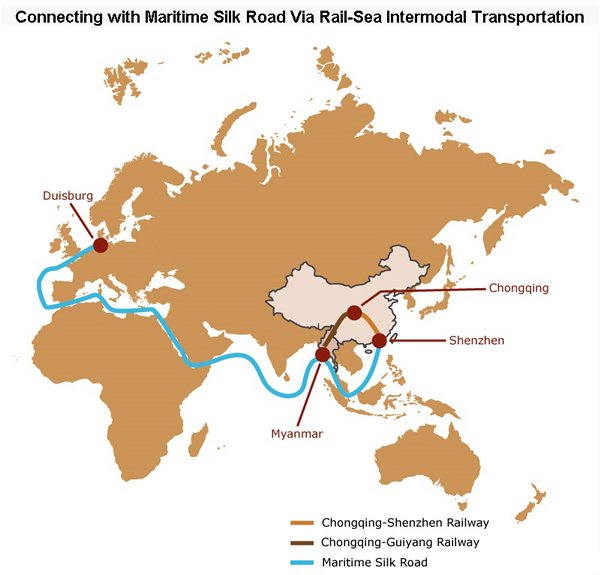
Opportunities for Hong Kong Businesses
The “One Belt, One Road” initiative is China’s important development strategy during the 13th Five-Year Plan period (2016-2020). Under this strategy, Chongqing, which plays an important role as the main transport hub between western China and Europe, will find great scope and opportunities for development. In addition to the Yuxinou railway, Chongqing’s railway network may also help export goods to the European market via the Maritime Silk Road by means of rail-sea intermodal transportation. The “One Belt, One Road” routes that connect the Asia-Pacific economy with the European economy pass through more than 60 countries and regions in Central Asia, Southeast Asia, South Asia and eastern Africa, where 4.4 billion people live. As Chongqing’s external logistics and transportation costs drop, and with the municipal government’s policy of fostering industrial clusters with special advantages, Hong Kong manufacturers may consider extending their production lines to Chongqing not only for export purposes but also to market their products to consumers in China's central and western regions as well as in countries along the "One Belt, One Road".
Apart from manufacturing enterprises, Hong Kong’s logistics companies may also take the opportunity to expand their business in Chongqing and in countries and regions along the “One Belt, One Road”. As freight volume on the Yuxinou railway grows, the catchment area of goods and destinations of delivery will also increase. In particular, the formation of its unique “1+N” pattern of convergence and distribution network will increase demand for logistics and other supporting services (such as finance and insurance) on a local level. On the other hand, the “One Belt, One Road” strategy will generate plenty of room for co-operation in such fields as infrastructure and finance. Hong Kong’s service providers should look out for new opportunities.
[1] China Railway plans to start construction of the Chongqing-Kunming Railway in 2016. The project is slated for completion in four years. It will only take about 2.5 hours to travel from Chongqing to Kunming when the railway is completed.
[2] The new Chongqing-Guiyang Railway is due for completion at the end of 2017, by which time it will only take two hours to travel from Chongqing to Guiyang.
| Content provided by |  |

